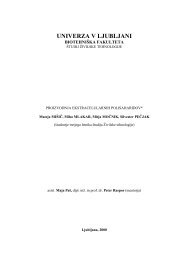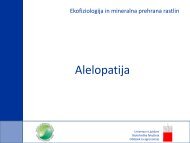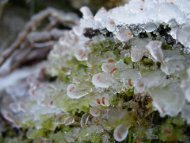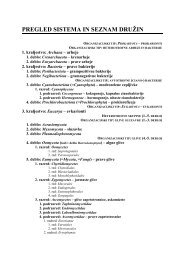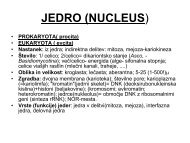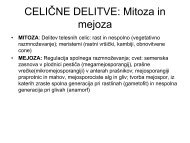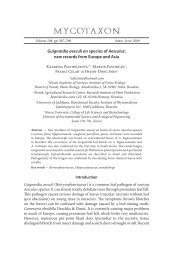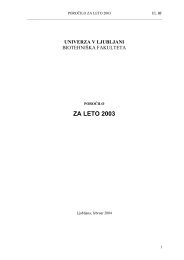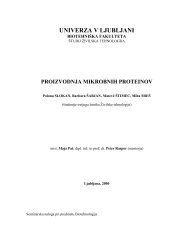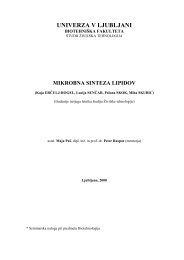research papers Structures of artificial sweeteners – cyclamic acid ...
research papers Structures of artificial sweeteners – cyclamic acid ...
research papers Structures of artificial sweeteners – cyclamic acid ...
Create successful ePaper yourself
Turn your PDF publications into a flip-book with our unique Google optimized e-Paper software.
esearch <strong>papers</strong><br />
Acta Crystallographica Section B<br />
Structural<br />
Science<br />
ISSN 0108-7681<br />
Ivan Leban, a * Darja Rudan-<br />
Tasič, b Nina Lah a and Cveto<br />
Kl<strong>of</strong>utar b<br />
a Faculty <strong>of</strong> Chemistry and Chemical Technology,<br />
University <strong>of</strong> Ljubljana, SI-1000 Ljubljana,<br />
Slovenia, and b Biotechnical Faculty,<br />
University <strong>of</strong> Ljubljana, SI-1000 Ljubljana,<br />
Slovenia<br />
Correspondence e-mail:<br />
ivan.leban@fkkt.uni-lj.si<br />
# 2007 International Union <strong>of</strong> Crystallography<br />
Printed in Singapore <strong>–</strong> all rights reserved<br />
<strong>Structures</strong> <strong>of</strong> <strong>artificial</strong> <strong>sweeteners</strong> <strong>–</strong> <strong>cyclamic</strong> <strong>acid</strong><br />
and sodium cyclamate with other cyclamates<br />
In the course <strong>of</strong> a study on <strong>artificial</strong> <strong>sweeteners</strong>, new crystal<br />
structures <strong>of</strong> <strong>cyclamic</strong> <strong>acid</strong>, sodium cyclamate, potassium<br />
cyclamate, ammonium cyclamate, rubidium cyclamate and<br />
tetra-n-propylammonium cyclamate have been determined.<br />
Cyclamic <strong>acid</strong> exists in its zwitterionic form in the crystalline<br />
state. The zwitterions are connected through hydrogen bonds<br />
<strong>of</strong> the N—H O type to form two-dimensional sheets. The<br />
sodium, potassium, ammonium and rubidium cyclamates are<br />
isostructural, with the cyclamate moieties linked through<br />
hydrogen bonds into linear chains. Taking into account the<br />
connectivity through cations, two-dimensional layers with a<br />
hydrophobic surface are constructed. In tetra(n-propyl)ammonium<br />
cyclamate the large, non-coordinating cation apparently<br />
prevents the formation <strong>of</strong> chains and thereby facilitates<br />
the centrosymmetric head-to-head discrete dimeric arrangement<br />
<strong>of</strong> the cyclamate moieties.<br />
1. Introduction<br />
Artificial <strong>sweeteners</strong> are chemical compounds classified as first<br />
generation (saccharin, cyclamate and aspartame) and new<br />
generation (acesulfame-K, sucralose, alitame, neotame and<br />
other sweet proteins). The sweet taste <strong>of</strong> cyclamates was<br />
discovered serendipitously by Sveda in 1937 (Audrieth &<br />
Sveda, 1944) and they were introduced commercially in the<br />
1950s. Today, <strong>cyclamic</strong> <strong>acid</strong> in the form <strong>of</strong> its sodium or<br />
calcium salt is one <strong>of</strong> the most widely used <strong>artificial</strong> <strong>sweeteners</strong><br />
in food and pharmaceuticals. It is in use in more than 50<br />
countries, especially in combination with other <strong>sweeteners</strong>, to<br />
eliminate aftertaste (for example, the synergistic effect <strong>of</strong><br />
saccharin<strong>–</strong>cyclamate; Verheyen, 1999; European Commission,<br />
2000, and references therein). However, the petition on<br />
<strong>cyclamic</strong> <strong>acid</strong>, calcium and sodium cyclamate is being held in<br />
abeyance with the FDA in the USA (CFSAN <strong>–</strong> Office <strong>of</strong> Food<br />
Additive Safety, 2006).<br />
Sweet-taste chemoreception originates in the interaction <strong>of</strong><br />
a sweet molecule with a putative taste-bud receptor.<br />
Exhaustive studies have been performed in an attempt to<br />
rationalize the sweet taste <strong>of</strong> particular compounds and to<br />
correlate the structure/taste relationship. It is generally<br />
accepted that the molecule <strong>of</strong> sweetener must possess specific<br />
geometrical features. The classical theories (Shallenberger et<br />
al., 1969; Kier, 1972) presume the existence <strong>of</strong> a glucophore<br />
with three specific sites: a hydrogen-bond donor and acceptor<br />
(AH—B) and a hydrophobic part X. The sweet response is<br />
elicited through the interaction <strong>of</strong> such a glucophore with the<br />
complementary tripartite AH—B—X site in the taste-bud<br />
receptor. The tripartite glucophore concept (despite the<br />
neglect <strong>of</strong> the three-dimensional shape) has its merits as a<br />
Received 20 January 2007<br />
Accepted 22 March 2007<br />
418 doi:10.1107/S0108768107013961 Acta Cryst. (2007). B63, 418<strong>–</strong>425
esearch <strong>papers</strong><br />
Table 1<br />
Crystal and experimental for <strong>cyclamic</strong> <strong>acid</strong> (I), sodium cyclamate (II), potassium cyclamate (III), ammonium cyclamate (IV), rubidium cyclamate (V)<br />
and tetra-n-propylammonium cyclamate (VI).<br />
(I) (II) (III)<br />
Crystal data<br />
Chemical formula C 6H 13NO 3S Na + C 6H 12NSO 3 K + C 6H 12NSO 3<br />
M r 179.23 201.22 217.33<br />
Cell setting, space group Monoclinic, P2/c Monoclinic, C2/c Monoclinic, C2/c<br />
Temperature (K) 150 (1) 150 (1) 150 (1)<br />
a, b, c (A ˚ ) 8.1711 (10), 10.9972 (12), 9.4601 (11) 31.083 (6), 6.2718 (14), 8.5682 (17) 33.656 (8), 6.274 (3), 8.572 (4)<br />
( ) 91.575 (5) 94.481 (10) 93.350 (10)<br />
V (A ˚ 3 ) 849.72 (17) 1665.3 (6) 1807.0 (13)<br />
Z 4 8 8<br />
Dx (Mg m 3 ) 1.401 1.605 1.598<br />
Radiation type Mo K Mo K Mo K<br />
(mm 1 ) 0.34 0.40 0.79<br />
Crystal form, colour Plate, colourless Plate, colourless Prism, colourless<br />
Crystal size (mm) 0.24 0.24 0.07 0.20 0.18 0.08 0.13 0.13 0.12<br />
Data collection<br />
Diffractometer Nonius KappaCCD Nonius KappaCCD Nonius KappaCCD<br />
Data collection method ! scans at =55 ! scans at =55 ! scans at =55<br />
Absorption correction Multi-scan (based on symmetry- Multi-scan (based on symmetry- Multi-scan (based on symmetryrelated<br />
measurements)<br />
related measurements)<br />
related measurements)<br />
Tmin 0.928 0.928 0.905<br />
Tmax 0.980 0.961 0.911<br />
No. <strong>of</strong> measured, independent and<br />
observed reflections<br />
10 483, 2195, 1955 10 594, 1923, 1480 75 861, 1953, 1565<br />
Criterion for observed reflections I >2 (I) I >2 (I) I >2 (I)<br />
Rint 0.033 0.049 0.043<br />
max ( ) 28.7 27.7 27.4<br />
Refinement<br />
Refinement on F 2<br />
F 2<br />
F 2<br />
R[F 2 >2 (F 2 )], wR(F 2 ), S 0.034, 0.090, 1.12 0.053, 0.130, 1.06 0.037, 0.090, 1.07<br />
No. <strong>of</strong> reflections 2195 1923 1953<br />
No. <strong>of</strong> parameters 108 113 113<br />
H-atom treatment Mixture <strong>of</strong> independent and<br />
Mixture <strong>of</strong> independent and<br />
Mixture <strong>of</strong> independent and<br />
constrained refinement<br />
constrained refinement<br />
constrained refinement<br />
Weighting scheme w = 1/[ 2 (F2 o) + (0.0224P) 2 + 0.7859P],<br />
where P =(F2 o +2F2 c )/3<br />
w = 1/[ 2 (F2 o) + (0.0356P) 2 + 6.6274P],<br />
where P =(F2 o +2F2 c )/3<br />
w =1/[ 2 (F2 o) + (0.0303P) 2 + 3.2501P],<br />
where P =(F2 o +2F2 ( / )max<br />
max, min (e A<br />
< 0.0001 < 0.0001<br />
c )/3<br />
0.001<br />
˚ 3<br />
) 0.47, 0.41 0.70, 0.56 0.36, 0.44<br />
(IV) (V) (VI)<br />
Crystal data<br />
Chemical formula NH þ 4 C 6H 12NSO 3 Rb + C 6H 12NSO 3 C 12H 28N + C 6H 12NSO 3<br />
M r 196.27 263.70 364.58<br />
Cell setting, space group Monoclinic, C2/c Monoclinic, C2/c Monoclinic, P2 1/n<br />
Temperature (K) 150 (1) 293 (1) 150 (1)<br />
a, b, c (A ˚ ) 33.6671 (19), 6.4571 (12), 8.7572 (15) 34.039 (5), 6.451 (2), 8.811 (2) 10.9510 (11), 13.5112 (12), 14.6202 (15)<br />
( ) 92.961 (2) 92.670 (10) 99.425 (5)<br />
V (A ˚ 3 ) 1901.1 (5) 1932.7 (8) 2134.0 (4)<br />
Z 8 8 4<br />
D x (Mg m 3 ) 1.371 1.813 1.135<br />
Radiation type Mo K Mo K Mo K<br />
(mm 1 ) 0.32 5.31 0.17<br />
Crystal form, colour Plate, colourless Plate, colourless Prism, colourless<br />
Crystal size (mm) 0.29 0.24 0.10 0.12 0.11 0.09 0.16 0.14 0.12<br />
Data collection<br />
Diffractometer Nonius KappaCCD Nonius KappaCCD Nonius KappaCCD<br />
Data collection method ! scans at =55 ! scans ! scans at =55<br />
Absorption correction Multi-scan (based on symmetry- Multi-scan (based on symmetry- Multi-scan (based on symmetryrelated<br />
measurements)<br />
related measurements)<br />
related measurements)<br />
Tmin 0.905 0.536 0.961<br />
Tmax 0.975 0.625 0.984<br />
No. <strong>of</strong> measured, independent<br />
and observed reflections<br />
24 925, 1936, 1650 10 240, 2549, 2327 25 465, 5074, 3955<br />
Criterion for observed<br />
reflections<br />
I >2 (I) I >2 (I) I >2 (I)<br />
Rint 0.045 0.039 0.044<br />
Acta Cryst. (2007). B63, 418<strong>–</strong>425 Ivan Leban et al. <strong>Structures</strong> <strong>of</strong> <strong>artificial</strong> <strong>sweeteners</strong> 419
esearch <strong>papers</strong><br />
Table 1 (continued)<br />
(IV) (V) (VI)<br />
max ( ) 26.4 29.1 27.9<br />
Refinement<br />
Refinement on F 2<br />
F 2<br />
F 2<br />
R[F 2 >2 (F 2 )], wR(F 2 ), S 0.042, 0.091, 1.20 0.024, 0.060, 1.10 0.041, 0.131, 1.06<br />
No. <strong>of</strong> reflections 1936 2549 5074<br />
No. <strong>of</strong> parameters 126 113 225<br />
H-atom treatment Mixture <strong>of</strong> independent and<br />
Mixture <strong>of</strong> independent and<br />
Mixture <strong>of</strong> independent and<br />
constrained refinement<br />
constrained refinement<br />
constrained refinement<br />
Weighting scheme w = 1/[ 2 (F2 o) + (0.0148P) 2 + 3.707P],<br />
where P =(F2 o +2F2 c )/3<br />
w = 1/[ 2 (F2 o) + (0.0179P) 2 + 2.7361P],<br />
where P =(F2 o +2F2 c )/3<br />
w = 1/[ 2 (F2 o) + (0.0713P) 2 + 0.5733P],<br />
where P =(F2 o +2F2 ( / )max<br />
max, min (e A<br />
Table 2<br />
Selected geometric data (A ˚ , ) for <strong>cyclamic</strong> <strong>acid</strong> (I), sodium cyclamate (II), potassium cyclamate (III),<br />
ammonium cyclamate (IV), rubidium cyclamate (V) and tetrapropylammonium cyclamate (VI).<br />
Compound (I) (II) (III) (IV) (V) (VI)<br />
S—O1 1.4290 (12) 1.457 (2) 1.4588 (16) 1.4610 (15) 1.4558 (14) 1.4560 (12)<br />
S—O2 1.4441 (11) 1.470 (2) 1.4592 (18) 1.4504 (16) 1.4526 (16) 1.4497 (12)<br />
S—O3 1.4407 (11) 1.448 (2) 1.4544 (18) 1.4472 (15) 1.4523 (15) 1.4645 (11)<br />
S—N 1.8003 (14) 1.643 (2) 1.641 (2) 1.6559 (18) 1.6401 (16) 1.6720 (14)<br />
N—C1 1.511 (2) 1.478 (4) 1.480 (3) 1.481 (3) 1.474 (2) 1.472 (2)<br />
C1—C2 1.521 (2) 1.532 (4) 1.530 (3) 1.526 (3) 1.515 (3) 1.522 (2)<br />
C2—C3 1.527 (3) 1.528 (4) 1.536 (3) 1.530 (3) 1.541 (3) 1.530 (2)<br />
C3—C4 1.523 (3) 1.533 (5) 1.525 (4) 1.522 (4) 1.515 (4) 1.523 (3)<br />
C5—C6 1.536 (3) 1.528 (4) 1.526 (4) 1.534 (3) 1.540 (4) 1.531 (3)<br />
C1—C6 1.524 (2) 1.531 (4) 1.527 (3) 1.525 (3) 1.520 (3) 1.522 (2)<br />
C2—C1—N—S 63.07 (15) 70.7 (3) 81.3 (2) 82.0 (2) 85.8 (2) 67.01 (16)<br />
O1—S—N—C1 155.71 (11) 168.4 (2) 174.77 (17) 179.30 (16) 174.57 (14) 151.49 (12)<br />
O2—S—N—C1 83.55 (11) 74.2 (2) 54.1 (2) 60.26 (18) 53.93 (17) 88.91 (13)<br />
O3—S—N—C1 34.70 (12) 46.9 (2) 67.0 (2) 61.09 (18) 67.25 (16) 31.70 (14)<br />
C1—C2—C3—C4 57.3 (2) 55.0 (4) 56.7 (3) 56.0 (3) 55.7 (3) 55.89 (19)<br />
C2—C3—C4—C5 56.6 (2) 54.6 (4) 55.5 (3) 55.3 (3) 54.6 (4) 53.9 (2)<br />
C3—C4—C5—C6 56.5 (2) 54.9 (4) 54.6 (3) 55.1 (3) 54.6 (4) 53.8 (2)<br />
C4—C5—C6—C1 57.4 (2) 56.4 (4) 54.8 (3) 55.5 (3) 54.7 (4) 56.3 (2)<br />
C5—C6—C1—C2 59.6 (2) 56.6 (3) 55.2 (3) 55.7 (3) 54.7 (3) 58.19 (19)<br />
C6—C1—C2—C3 59.41 (19) 55.4 (3) 56.1 (3) 56.2 (3) 55.7 (3) 57.76 (18)<br />
H—N—C1—H1a 176.6 175.1 169.8 164.4 162.8 71 (2)<br />
H—N—S—O1 82.0 (14) 64 (2) 43 (2) 52.0 (18) 44.2 (18) 28.5 (17)<br />
H—N—S—O2 38.7 (14) 53 (2) 78 (2) 68.5 (18) 76.4 (18) 148.1 (17)<br />
H—N—S—O3 157.0 (14) 174 (2) 161 (2) 170.2 (18) 162.4 (18) 91.3 (17)<br />
H1—NS—O1 32.9 (15)<br />
H1—N—S—O2 153.7 (15)<br />
H1—N—S—O3 88.1 (15)<br />
The labelling for the sulfamyl H atoms <strong>of</strong> <strong>cyclamic</strong> <strong>acid</strong> (I) has been changed slightly <strong>–</strong> H and H1 are attached to N.<br />
2. Experimental<br />
2.1. Sample preparation and crystallization<br />
Crystals <strong>of</strong> <strong>cyclamic</strong> <strong>acid</strong> were prepared by dissolving a<br />
sample <strong>of</strong> commercially available <strong>cyclamic</strong> <strong>acid</strong> (Sigma<strong>–</strong><br />
Aldrich) in distilled water under gentle heating. Slow<br />
evaporation <strong>of</strong> water at ambient temperature produced<br />
transparent prismatic crystals <strong>of</strong> <strong>cyclamic</strong> <strong>acid</strong> (I) within<br />
2 weeks. Crystals <strong>of</strong> sodium cyclamate (II), potassium cyclamate<br />
(III), ammonium cyclamate (IV) and tetra-n-propylammonium<br />
cyclamate (VI) were obtained by slow evaporation<br />
<strong>of</strong> water from the aqueous solutions containing equimolar<br />
amounts <strong>of</strong> <strong>cyclamic</strong> <strong>acid</strong> and the corresponding hydroxide.<br />
Rubidium cyclamate (V) crystals were obtained by dissolving<br />
<strong>research</strong> <strong>papers</strong><br />
<strong>cyclamic</strong> <strong>acid</strong> and Rb 2CO 3 in<br />
distilled water in a 2:1 molar ratio.<br />
On standing at ambient temperature<br />
colourless crystals appeared<br />
within a week. Crystals <strong>of</strong> several<br />
other cyclamates have also been<br />
prepared, but their limited quality<br />
did not allow a full X-ray structure<br />
determination (Leban et al., 2005).<br />
2.2. Data collection and structure<br />
determination<br />
All crystallographic measurements<br />
were performed on a Nonius<br />
Kappa CCD diffractometer<br />
(Mo K radiation, 55 kV, 30 mA)<br />
equipped with an Oxford Cryosystems<br />
Series 700 open-flow<br />
cryostat (Cosier & Glazer, 1986).<br />
The diffraction data [with the<br />
exception <strong>of</strong> that for the rubidium<br />
salt, 293 (1) K] were collected at<br />
150 (1) K. The standard strategy<br />
was used for data collection, cell<br />
refinement and data reduction<br />
(Ho<strong>of</strong>t, 1998; Otwinowski &<br />
Minor, 1997). SIR92 (Altomare et<br />
al., 1993) and SHELXS97 (Sheldrick,<br />
1997) implemented in<br />
Version 1.64 <strong>of</strong> the WinGX program package (Farrugia, 1999)<br />
were used for structure solution by direct methods.<br />
SHELXL97 (Sheldrick, 1997) was used for structure refinement<br />
and the calculation <strong>of</strong> difference Fourier maps. The<br />
structures were refined by full-matrix least-squares against F 2<br />
using all data. H atoms have been located from the difference-<br />
Fourier maps and those <strong>of</strong> the sulfamate groups were refined<br />
isotropically without restraints. Those <strong>of</strong> the cyclohexane<br />
moieties and the tetra-n-propylammonium cation in (VI) were<br />
placed at calculated positions and treated as riding with Uiso<br />
values set to 1.2 or 1.5 Ueq <strong>of</strong> the parent atom. For visual<br />
interpretation and structural drawings the following programs<br />
were used: ORTEP3 for Windows (Farrugia, 1997), PLATON<br />
(Spek, 2003) and MERCURY (Macrae et al., 2006). Selected<br />
experimental and crystal data for <strong>cyclamic</strong> <strong>acid</strong> and reported<br />
cyclamates are given in Table 1. Inspection <strong>of</strong> the crystal data<br />
in Table 1 1 shows the isostructurality <strong>of</strong> sodium, potassium,<br />
ammonium and rubidium cyclamates. The separate structures<br />
<strong>of</strong> <strong>cyclamic</strong> <strong>acid</strong> (I), sodium cyclamate (II) and tetra-npropylammonium<br />
cyclamate (VI) together with molecular<br />
packing are depicted in Figs. 1, 2 and 3, respectively. In order<br />
to facilitate comparison, all atomic labelling was kept the<br />
same, the sulfamyl N atoms are marked as N, and the<br />
hydrogen attached to it is marked as H. The additional H atom<br />
1 Supplementary data for this paper are available from the IUCr electronic<br />
archives (Reference: BM5046). Services for accessing these data are described<br />
at the back <strong>of</strong> the journal.<br />
Acta Cryst. (2007). B63, 418<strong>–</strong>425 Ivan Leban et al. <strong>Structures</strong> <strong>of</strong> <strong>artificial</strong> <strong>sweeteners</strong> 421
esearch <strong>papers</strong><br />
attached to N in <strong>cyclamic</strong> <strong>acid</strong> (I) is labelled as H1. The O3<br />
atom <strong>of</strong> each sulfo group is always positioned above the plane<br />
<strong>of</strong> the cyclohexane moiety, on the same side as H1A, H3A or<br />
H5A. Some selected geometric data generated by PARST<br />
(Nardelli, 1983, 1995) are collected in Table 2.<br />
3. Results and discussion<br />
3.1. Crystal structure <strong>of</strong> <strong>cyclamic</strong> <strong>acid</strong> (I)<br />
A prominent feature <strong>of</strong> <strong>cyclamic</strong> <strong>acid</strong> is that it can exist as a<br />
neutral molecule [see (Ia)] or in the zwitterionic form [see<br />
Figure 2<br />
ORTEP3 drawing (Farrugia, 1997) <strong>of</strong> sodium cyclamate (a) (displacement ellipsoids<br />
are drawn at the 50% probability level) and the crystal packing (b) and (c), where H<br />
atoms are omitted for clarity.<br />
(Ib)]. Analysis <strong>of</strong> the crystals <strong>of</strong> (I) has proved the existence <strong>of</strong><br />
the zwitterionic structure (Fig. 1). The formulation was readily<br />
established by the straightforward identification <strong>of</strong> two Hatom<br />
sites adjacent to the N atom and it is further supported<br />
by a number <strong>of</strong> metrical features. The protonation <strong>of</strong> nitrogen<br />
affects the N—S bond length [1.8003 (14) A˚ ], which is significantly<br />
longer than the N—S distances observed in related<br />
compounds (Allen et al., 1995) and the cyclamates reported<br />
here. The S—O distances are 1.4290 (12), 1.4441 (11) and<br />
1.4407 (11) A˚ for S—O1, S—O2 and S—O3, respectively. The<br />
orientation <strong>of</strong> the sulfamyl group results in a torsion angle for<br />
S—N—C1—C2 <strong>of</strong> 63.07 (15) . Selected geometric<br />
parameters are listed in Table 2 and those <strong>of</strong><br />
hydrogen bonding in Table 3. The two sulfamyl H<br />
atoms are involved in the formation <strong>of</strong> three<br />
hydrogen bonds <strong>of</strong> the N—H O type. The N—<br />
H2 O3 (symmetry code: x; y; z) hydrogen<br />
bond connects the molecules into centrosymmetric<br />
dimers, which are further linked into chains along<br />
the x axis through an N—H1—O2 (symmetry code:<br />
1 x; y; z) interaction. In addition, these<br />
chains are connected into two-dimensional layers<br />
through N—H2 O3 (symmetry code:<br />
1 x; y; z 2 ). Thus, the polar sulfamyl cores lie on a<br />
layer almost parallel to the ac plane, whereas the<br />
cyclohexane tails protrude from each side <strong>of</strong> the<br />
layer bringing the hydrophobic parts <strong>of</strong> adjacent<br />
layers together (Figs. 1 and 4).<br />
3.2. Crystal structures <strong>of</strong> Na + ,K + ,NH 4 + and Rb +<br />
cyclamates (II, III, IV, V)<br />
Sodium, potassium, ammonium and rubidium<br />
cyclamates are isostructural. A view <strong>of</strong> the asymmetric<br />
unit <strong>of</strong> sodium cyclamate (I) is depicted in<br />
Fig. 2. For clear comparison <strong>of</strong> the structures, the<br />
same atomic labelling scheme was used. A striking<br />
difference between the structure <strong>of</strong> the cyclamate<br />
anion and the <strong>cyclamic</strong> <strong>acid</strong> zwitterion is the S—N<br />
bond length. The S—N distances <strong>of</strong> 1.643 (2),<br />
1.641 (2), 1.6559 (18) and 1.6401 (16) A ˚ for (II),<br />
(III), (IV) and (V), respectively, are considerably<br />
shorter than that observed in <strong>cyclamic</strong> <strong>acid</strong>,<br />
1.8003 (14) A ˚ . A similar observation was made for<br />
the structures <strong>of</strong> sulfamic <strong>acid</strong> (Sass, 1960) and its<br />
ammonium salt (Cain & Kanda, 1972). Apparently,<br />
the free electron pair on the sulfamyl nitrogen in<br />
the cyclamate anion is involved in attractive interactions<br />
with the empty d orbital <strong>of</strong> the S atom,<br />
resulting in shortening <strong>of</strong> the S—N bond. The<br />
values <strong>of</strong> the S—N—C1—C2 torsion angles<br />
[70.7 (3), 81.3 (2), 82.0 (2), 85.8 (2) ] are higher<br />
than the corresponding torsion angle in <strong>cyclamic</strong><br />
<strong>acid</strong> [63.07 (15) ], but the values differ significantly<br />
even within the group <strong>of</strong> four isostructural<br />
compounds. Thus, no conclusion regarding the<br />
orientation <strong>of</strong> the sulfamyl group can be drawn.<br />
422 Ivan Leban et al. <strong>Structures</strong> <strong>of</strong> <strong>artificial</strong> <strong>sweeteners</strong> Acta Cryst. (2007). B63, 418<strong>–</strong>425
Table 3<br />
Details <strong>of</strong> hydrogen bonding for <strong>cyclamic</strong> <strong>acid</strong> (I), sodium cyclamate (II) and tetra-npropylammonium<br />
cyclamate (VI).<br />
<strong>research</strong> <strong>papers</strong><br />
The single H atom on the sulfamyl N is<br />
involved in the formation <strong>of</strong> an inter-<br />
molecular N—H O3 (symmetry code:<br />
x; y; 1<br />
2 þ z) hydrogen bond that<br />
connects the cyclamate moieties into<br />
linear chains propagating along the b<br />
axis.<br />
The monovalent cations (Na + ,K + and<br />
Rb + ) are located between these chains<br />
and are coordinated predominantly by<br />
the O atoms <strong>of</strong> sulfo groups in such a<br />
way that two-dimensional layers are<br />
formed perpendicular to the a axis. The<br />
sodium cation in (II) is coordinated by<br />
six O atoms <strong>of</strong> five different sulfo<br />
groups. Five Na + O distances span a<br />
range between 2.302 (3) and<br />
2.480 (3) A˚ , whereas an additional<br />
oxygen is located at a longer distance<br />
[2.859 (3) A˚ ]. The potassium cation in (III) is ninecoordinated<br />
with eight K + O distances spanning<br />
the range 2.727 (2)<strong>–</strong>3.234 (2) A˚ and additionally<br />
the sulfamyl nitrogen is coordinated as a possible<br />
donor <strong>of</strong> a free electron pair to K + at 2.911 (2) A˚ .<br />
The rubidium cation in (V) was found to be tencoordinated<br />
by nine O atoms in the range<br />
2.916 (2)<strong>–</strong>3.332 (2) A˚ with the additional sulfamyl<br />
nitrogen at 3.052 (2) A˚ (Harding, 2002). The<br />
ammonium cation (NHþ 4 ) in (IV) serves as a Hatom<br />
donor for hydrogen bonds to the neighbouring<br />
sulfo O atoms, but the formation <strong>of</strong><br />
hydrogen bonds does not influence the basic<br />
structural arrangement. There is no covalent<br />
interaction between the layers, which are separated<br />
from each other by the hydrophobic cyclohexane<br />
parts <strong>–</strong> protruding from both sides. It is<br />
interesting to note that the sodium, potassium,<br />
rubidium and ammonium cylamates are isostructural:<br />
because <strong>of</strong> the smaller size <strong>of</strong> the Na + cation,<br />
the sodium salt does not normally fit into such a<br />
series, as exemplified by alkali hydrogen acetylenedicarboxylates<br />
[Na + (Leban, 1974a); K +<br />
(Leban et al., 1973); Rb + (Blain et al., 1973); NHþ (I) (II) (VI)<br />
N O2<br />
4<br />
(Leban, 1974b)] and alkali naphthalenetetracarboxylates<br />
(Fitzgerald et al., 1993).<br />
i<br />
2.875 (2) N O3 iv<br />
3.061 (3) N O1 v<br />
2.983 (2)<br />
N—H1 0.91 (2) N—H 0.95 (4) N—H 0.73 (2)<br />
H1 O2 i<br />
1.98 (2) H O3 iv<br />
2.16 (4) H O1 v<br />
2.25 (2)<br />
N—H1 O2 i<br />
168 (2) N—H O3 iv<br />
159 (3) N—H O1 v<br />
173 (2)<br />
N O3 ii<br />
3.029 (2)<br />
N—H2 0.83 (2)<br />
H2 O3 ii<br />
2.26 (2)<br />
N—H2 O3 ii<br />
156 (2)<br />
N O3 iii<br />
3.030 (2)<br />
N—H2 0.83 (2)<br />
H2 O3 iii<br />
2.46 (2)<br />
N—H2 O3 iii<br />
127 (2)<br />
1 Symmetry codes: (i) x þ 1; y; z; (ii) x; y; þz 2 ; (iii) x; y; z; (iv) x; y; þz þ 1 2 ; (v) 1 x; 1 y; 1 z.<br />
Figure 3<br />
ORTEP3 drawing (Farrugia, 1997) <strong>of</strong> tetra-n-propylammonium cyclamate (a)<br />
(displacement ellipsoids are drawn at the 50% probability level) and the crystal<br />
packing (b) and (c). H atoms are omitted for clarity. Only anions are shown in (c).<br />
3.3. Crystal structure <strong>of</strong> tetra-n-propylammonium<br />
cyclamate (VI)<br />
The geometry <strong>of</strong> the cyclamate anion (Fig. 3) is<br />
similar to that observed for the other cyclamates<br />
reported here, however, the packing <strong>of</strong> the cyclamate<br />
moieties is influenced by the size and nature<br />
<strong>of</strong> the cation. Besides the greater size, the tetra-npropylammonium<br />
cation lacks the coordination<br />
abilities and the possibilities for the formation <strong>of</strong><br />
hydrogen bonds. Thus, no extended arrangements<br />
Acta Cryst. (2007). B63, 418<strong>–</strong>425 Ivan Leban et al. <strong>Structures</strong> <strong>of</strong> <strong>artificial</strong> <strong>sweeteners</strong> 423
esearch <strong>papers</strong><br />
are expected. The cyclamate units, related by the crystallographic<br />
inversion center, are connected to centrosymmetric<br />
dimers through N—H O interactions (Fig. 4), forming eightmembered<br />
R2 2ðÞrings 8 (Bernstein et al., 1995), which are<br />
already observed as a linking motif in (I). There are no other<br />
connections. The cyclamate moieties are arranged in columns<br />
<strong>of</strong> dimers, propagating along b, separated by columns <strong>of</strong><br />
cationic moieties (Fig. 3). Comparison <strong>of</strong> the structures <strong>of</strong><br />
cyclamate moieties in the reported cyclamates shows one<br />
significant difference. While the S—O3 and N—H groups in<br />
the sulfamate moieties are oriented trans to one another in<br />
sodium cyclamate (II) and in its isostructural compounds (III),<br />
(IV) and (V), the torsion angle N—H—S—O3 has a value <strong>of</strong><br />
91.3 (17) in (VI). The orientation <strong>of</strong> the sulfamyl H atom is<br />
probably affected by the formation <strong>of</strong> centrosymmetric<br />
dimers, since the dimeric arrangement was also observed for<br />
<strong>cyclamic</strong> <strong>acid</strong> which contains two H atoms, one <strong>of</strong> which is in a<br />
Figure 4<br />
Graphic representation <strong>of</strong> the hydrogen bonding (MERCURY; Macrae et<br />
al., 2006) in (a) <strong>cyclamic</strong> <strong>acid</strong> (I), (b) sodium cyclamate (II) and (c) tetran-propylammonium<br />
cyclamate (VI).<br />
suitable orientation to form such dimers. Cyclamic <strong>acid</strong> as well<br />
as sodium and related cyclamates taste sweet, while the tetran-propylammonium<br />
salt tastes bitter. It seems that the position<br />
<strong>of</strong> the H atom on the sulfamyl nitrogen and consequently<br />
the hydrogen-bonding pattern is not the major ‘sweetness<br />
factor’, but the size and nature <strong>of</strong> the cation also possibly<br />
influences the sweetness. The remarkable structural feature<br />
common to all the sweet cyclamate species, but lacking in the<br />
bitter tetra-n-propylammonium salt, is the formation <strong>of</strong> twodimensional<br />
sheets with a hydrophobic surface. Additionally,<br />
in (VI) the hydrogen <strong>of</strong> the sulfamate moiety is attached on<br />
the other (<strong>of</strong> two) possible position at the N atom.<br />
4. Concluding comments<br />
The structural analyses <strong>of</strong> <strong>cyclamic</strong> <strong>acid</strong> and its five salts show<br />
similar geometry for the cyclamate moieties, but with different<br />
packing arrangements in the crystal.<br />
Generally, two types <strong>of</strong> packing were observed:<br />
(i) the formation <strong>of</strong> a layered two-dimensional structure<br />
with a hydrophobic surface and<br />
(ii) the discrete arrangement <strong>of</strong> cyclamate dimers without<br />
further interactions that would form extended arrangements.<br />
The latter was observed for tetra-n-propylammonium cyclamate,<br />
which alone among the reported compounds tastes<br />
bitter, while all others have a sweet taste. Nevertheless,<br />
additional data are needed to confirm the speculation that the<br />
packing in the solid state can also have an influence on the<br />
sweet-taste perception.<br />
These observations, together with previous investigations,<br />
show that the relationship between sweetness and structure is<br />
not an obvious one. This in turn means that the search for<br />
simple principles in the design <strong>of</strong> <strong>sweeteners</strong> will require<br />
further studies and considerably more sophisticated models<br />
than those currently available. However, we believe that the<br />
structural analyses <strong>of</strong> <strong>cyclamic</strong> <strong>acid</strong> and cyclamates will assist<br />
further <strong>research</strong> on the topic.<br />
The financial support <strong>of</strong> the Ministry <strong>of</strong> Higher Education,<br />
Science and Technology, Republic <strong>of</strong> Slovenia, through grants<br />
P1-0175-2005 and X-2000 is gratefuly acknowledged.<br />
References<br />
Allen, F. H., Watson, D. G., Brammer, L., Orpen, A. G. & Taylor, R.<br />
(1995). International Tables for Crystallography, edited by A. J. C.<br />
Wilson, Vol. C, pp. 685<strong>–</strong>706. Dordrecht: Kluwer Academic<br />
Publishers.<br />
Altomare, A., Cascarano, G., Giacovazzo, C. & Guagliardi, A. (1993).<br />
J. Appl. Cryst. 26, 343<strong>–</strong>350.<br />
Audrieth, L. F. & Sveda, M. (1944). J. Org. Chem. 9, 89<strong>–</strong>101.<br />
Barker, J. S., Hattotuwagama, C. K. & Drew, M. G. B. (2002). Pure<br />
Appl. Chem. 74, 1207<strong>–</strong>1217.<br />
Bassoli, A., Drew, M. G. B., Merlini, L. & Morini, G. (2002). J. Med.<br />
Chem. 45, 4402<strong>–</strong>4409.<br />
Bernstein, J., Davis, R. E., Shimoni, L. & Chang, N.-L. (1995). Angew.<br />
Chem. Int. Ed. Engl. 34, 1555<strong>–</strong>1573.<br />
Benson, G. A. & Spillane, W. J. (1980). Chem. Rev. 80, 151<strong>–</strong>186.<br />
Birch, G. G. (2002). Pure Appl. Chem. 74, 1103<strong>–</strong>1108.<br />
424 Ivan Leban et al. <strong>Structures</strong> <strong>of</strong> <strong>artificial</strong> <strong>sweeteners</strong> Acta Cryst. (2007). B63, 418<strong>–</strong>425
Birch, G. G., Haywood, K. A., Hanniffly, G. G., Coyle, C. M. &<br />
Spillane, W. J. (2004). Food Chem. 84, 429<strong>–</strong>435.<br />
Blain, J., Speakman, J. C., Stamp, L. A., Golič, L. & Leban, I. (1973).<br />
J. Chem. Soc. pp. 706<strong>–</strong>710.<br />
Bruck, S. D. & Stemple, N. R. (1967). J. Phys. Chem. 41, 3336<strong>–</strong><br />
3337.<br />
Cain, B. E. & Kanda, F. A. (1972). Z. Kristallogr. 135, 253<strong>–</strong>261.<br />
CFSAN <strong>–</strong> Office <strong>of</strong> Food Additive Safety (2006). Petitions Currently<br />
Held in Abeyance. http://www.cfsan.fda.gov/~dms/opa-abey.html.<br />
Cosier, J. & Glazer, A. M. (1986). J. Appl. Chem. 19, 105<strong>–</strong>107.<br />
Ellis, J. W. (1995). J. Chem. Educ. 72, 671<strong>–</strong>675.<br />
European Commission (2000). Revised opinion on <strong>cyclamic</strong> <strong>acid</strong> and<br />
its sodium and calcium salts; http://ec.europa.eu/food/fs/sc/scf/<br />
out53_en.pdf.<br />
Farrugia, L. J. (1997). J. Appl. Cryst. 30, 565.<br />
Farrugia, L. J. (1999). J. Appl. Cryst. 32, 837<strong>–</strong>838.<br />
Farrugia, L. J. (2000). Implementation <strong>of</strong> PLATON for 32-bit<br />
Windows. University <strong>of</strong> Glasgow, Scotland.<br />
Feinstein, R. D., Polinsky, A., Douglas, A. J., Magnus, C., Beijer, F. G.,<br />
Chadha, R. K., Benedetti, E. & Goodman, M. (1991). J. Am. Chem.<br />
Soc. 113, 3467<strong>–</strong>3473.<br />
Fitzgerald, L. J., Gallucci, J. C. & Gerkin, R. E. (1993). Acta Cryst.<br />
C49, 1287<strong>–</strong>1294.<br />
Goodman, M., Mattern, R. H., Gantzel, P., Santini, A., Iacovino, R.,<br />
Saviano, M. & Benedetti, E. (1997). J. Pept. Sci. 4, 229<strong>–</strong>238.<br />
Harding, M. M. (2002). Acta Cryst. D58, 872<strong>–</strong>874.<br />
Hatada, M., Jancarik, J., Graves, B. & Kim, S. H. (1985). J. Am. Chem.<br />
Soc. 107, 4279<strong>–</strong>4282.<br />
Ho<strong>of</strong>t, R. (1998). COLLECT. Nonius BV, The Netherlands.<br />
Immel, S. (1995). PhD thesis. Darmstadt University <strong>of</strong> Technology,<br />
Germany.<br />
Jiang, P., Cui, M., Zhao, B., Snyder, L. A., Benard, L. M. J., Osman, R.,<br />
Max, M. & Margolskee, R. F. (2005). J. Biol. Chem. 280, 34296<strong>–</strong><br />
34305.<br />
Johnson, C. K. (1976). ORTEPII. Report ORNL-5138. Oak Ridge<br />
National Laboratory, Tennessee, USA.<br />
Kanters, J. A., Scherrenberg, R. L., Leaflang, B. R., Kroon, J. &<br />
Mathlouthi, M. (1988). Carbohydr. Res. 180, 175<strong>–</strong>182.<br />
Kier, L. B. (1972). J. Pharm. Sci. 61, 1394<strong>–</strong>1397.<br />
Kl<strong>of</strong>utar, C., Horvat, J. & Rudan-Tasič, D. (2006a). Monatsh. Chem.<br />
137, 1151<strong>–</strong>1162.<br />
Kl<strong>of</strong>utar, C., Horvat, J. & Rudan-Tasič, D. (2006b). Acta Chim. Slov.<br />
53, 274<strong>–</strong>283.<br />
Kl<strong>of</strong>utar, C., Luci, M. & Abramovič, H. (1999). Physiol. Chem. Phys.<br />
Med. NMR, 31, 1<strong>–</strong>8.<br />
Kl<strong>of</strong>utar, C. & Rudan-Tasič, D. (2006). J. Solution Chem. 35, 395<strong>–</strong><br />
406.<br />
Leban, I. (1974a). Cryst. Struct. Commun. 3, 241<strong>–</strong>243.<br />
Leban, I. (1974b). Cryst. Struct. Commun. 3, 237<strong>–</strong>239.<br />
Leban, I., Golič, L. & Speakman, J. C. (1973). J. Chem. Soc. pp. 703<strong>–</strong><br />
705.<br />
Leban, I., Rudan-Tasič, D. & Kl<strong>of</strong>utar, C. (2005). Acta Cryst. A61,C-<br />
347.<br />
Lee, C.-K. (1987). Adv. Carbohydr. Chem. Biochem. 45, 199<strong>–</strong>351.<br />
Li, X., Staszewski, L., Xu, H., Durick, K., Zoller, M. & Adler, E.<br />
(2002). Proc. Natl. Acad. Sci. USA, 99, 4692<strong>–</strong>4696.<br />
<strong>research</strong> <strong>papers</strong><br />
Macrae, C. F., Edgington, P. R., McCabe, P., Pidcock, E., Shields, G. P.,<br />
Taylor, R., Towler, M. & van de Streek, J. (2006). J. Appl. Cryst. 39,<br />
453<strong>–</strong>457.<br />
Max, M., Shanker, Y. G., Rong, M., Liu, Z., Campagne, F., Weinstein,<br />
H., Damak, S. & Margolskee, R. F. (2001). Nature Genet. 28, 58<strong>–</strong><br />
63.<br />
Montmayeur, J.-P., Liberles, S. D., Matsunami, H. & Buck, L. B.<br />
(2001). Nature Neurosci. 4, 492<strong>–</strong>498.<br />
Morini, G., Bassoli, A. & Temussi, P. A. (2005). J. Med. Chem. 48,<br />
5520<strong>–</strong>5529.<br />
Nakajima, K.-I., Asakura, T., Maruyama, J.-I., Morita, Y., Oike, H.,<br />
Shimizu-Ibuka, A., Misaka, T., Sorimachi, H., Arai, S., Kitamoto, K.<br />
& Abe. K. (2006). Appl. Environ. Microbiol. 72, 3716<strong>–</strong>3723.<br />
Nardelli, M. (1983). Comput. Chem. 7, 95<strong>–</strong>97.<br />
Nardelli, M. (1995). J. Appl. Cryst. 28, 659.<br />
Okaya, Y. (1969). Acta Cryst. B25, 2257<strong>–</strong>2263.<br />
Otwinowski, Z. & Minor, W. (1997). Methods in Enzymology, Vol.<br />
276, Macromolecular Crystallography, edited by C. W. Carter &<br />
R. M. Sweet, Part A, pp. 307<strong>–</strong>326. London: Academic Press.<br />
Parke, S. A. & Birch, G. G. (1999). J. Agric. Food Chem. 47, 1378<strong>–</strong><br />
1384.<br />
Parke, S. A., Birch, G. G. & Dijk, R. (1999). Chem. Senses, 24, 271<strong>–</strong><br />
279.<br />
Paulus, E. F. (1975). Acta Cryst. B31, 1191<strong>–</strong>1193.<br />
Pautet, F., Kamoun, N. & Daudon, M. (1982). Pharm. Acta Helv. 57,<br />
205<strong>–</strong>208.<br />
Rudan-Tasič, D., Kl<strong>of</strong>utar, C. & Besˇter-Rogač, M. (2006). Acta Chim.<br />
Slov. 53, 324<strong>–</strong>330.<br />
Sass, R. L. (1960). Acta Cryst. 13, 320<strong>–</strong>324.<br />
Shallenberger, R. S., Acree, T. E. & Lee, C. Y. (1969). Nature, 221,<br />
555<strong>–</strong>556.<br />
Sheldrick, G. M. (1997). SHELXL97 and SHELXS97. University <strong>of</strong><br />
Göttingen, Germany.<br />
Spek, A. L. (2003). J. Appl. Cryst. 36, 7<strong>–</strong>13.<br />
Spillane, W. J. & Hanniffy, G. G. (2003). J. Agric. Food Chem. 51,<br />
3056<strong>–</strong>3059.<br />
Spillane, W. J., Sheahan, M. B., Simmie, J. M., Cunningham, D.,<br />
McArdle, P. & Higgins, T. (1989). J. Chem. Soc. Chem. Commun.<br />
pp. 545<strong>–</strong>547.<br />
Suami, T., Hough, L., Machinami, T., Saito, T. & Nakamura, K.<br />
(1998). Food Chem. 63, 391<strong>–</strong>396.<br />
Tinti, J.-M. & N<strong>of</strong>re, C. (1991). Sweeteners Discovery, Molecular<br />
Design and Chemoreception, edited by D. E. Walters, F. T.<br />
Orthoefer & G. E. DuBois, Am. Chem. Soc. Symposium Series,<br />
pp. 88<strong>–</strong>99. Washington: American Chemical Society.<br />
Verheyen, R. (1999). Rev. Eur. Community Int. Environ. Law, 8, 218<strong>–</strong><br />
220.<br />
Walters, D. E. (1995). J. Chem. Educ. 72, 680<strong>–</strong>683.<br />
Wardell, J. L., Low, J. N. & Glidewell, C. (2005). Acta Cryst. E61,<br />
o1944<strong>–</strong>o1946.<br />
Wink, D. J., Schroeder, S. A., Prakash, I., Lam, K.-C. & Rheingold,<br />
A. L. (1999). Acta Cryst. C55, 1365<strong>–</strong>1368.<br />
Yazicilar, T. K., Andac, O., Bekdemir, Y., Kutuk, H., Yilmaz, V. T. &<br />
Harrison W. T. A. (2002). Acta Cryst. C58, m21<strong>–</strong>m22.<br />
Zalewski, R. I. & Jasiczak, J. (1994). J. Chem. Inf. Comput. Sci. 34,<br />
179<strong>–</strong>183.<br />
Acta Cryst. (2007). B63, 418<strong>–</strong>425 Ivan Leban et al. <strong>Structures</strong> <strong>of</strong> <strong>artificial</strong> <strong>sweeteners</strong> 425




